[Updated February 5, 2019]
Does your dog know what “Sit!” means? Most people think their dogs do, because when they stand in front of their dogs looking down at them, pointing toward the ground, and saying, “Sit! Sit! Sit!”- their dogs sit! Voila!
I would argue that, in fact, the average dog who sits in that situation does not know the verbal cue, “Sit!” What he understands is that he should sit when he is confronted by his person standing in a certain position in relation to him, with a certain expression on her face, making a certain sound. If he really understood, “Sit!” he would sit (most of the time) when he heard anyone around him, in any position or posture, say, “Sit!”
You can test my theory. Say “Sit!” to your dog when you have your back to him and are looking up at the ceiling or with your arms crossed over your chest, or when you are hopping on one foot. If he sits when you do these things, then he really does understand the verbal cue, “Sit!”
An important goal of my Level 1 training classes is to teach people to use verbal cues with their dogs. Getting the dogs to perform various behaviors by using a combination of verbal cues, body language, and lures is easy. Getting the dogs to do the behaviors without the prompts, on just a verbal cue, is more challenging, but it’s of the utmost importance. After all, there are numerous situations where you have only your voice to communicate with your dog. There are times when your hands are full – of groceries, school books, laundry baskets, the baby. There are times when your dog cannot see you; he may be behind you, in another room, or behind a tree and about to cross a road. At some time in his life he may become visually impaired, no longer able to see and respond to your body language.
I teach hand signals in my Level 2 class. My students are generally delighted when they discover how much easier it is to get their dogs to respond to distinct body language cues for specific behaviors – much easier than it is to teach verbal cues. It’s easier because dogs are primarily body language communicators, and they have a large body vocabulary. The twitch of an ear, the shift of an eye, a slight turn of the head – these are just a few canine expressions that are rich with meaning to other dogs.
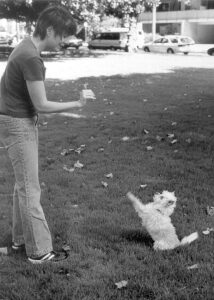
I teach hand signals because there are also times when visual cues are the communication tool of choice. You may be talking to someone – on the phone or in person – and do not want to interrupt the conversation in order to ask your dog to lie down. The new baby may finally be sleeping, and you don’t want to risk waking her by talking to your dog. As your canine pal ages, he may lose his hearing and no longer be able to hear and respond to verbal cues. And you may simply love the way your relationship is enhanced when you can communicate silently with your dog.
To review: If a dog is going to be taught just one clear cue for various behaviors, I think it’s most important to teach him an auditory cue. If a person takes his training further, he should learn visual cues, too. In the best of all possible worlds, a dog should know both types of cues for almost every basic behavior you want him to perform.
In past WDJ articles, I’ve mostly discussed teaching dogs verbal cues for various behaviors. Here, I’ll concentrate on how to teach him visual cues.
Training Your Dog with Hand Signals
There are two philosophies about hand signals. Some people like to use small, subtle signals, barely visible to the human eye. A tiny finger movement cues the dog to lie down. Another elicits a sit. A small wave sends the dog into heel position. Impressive – it appears that the dog is mind-reading!
The other school of thought advises that hand signals should be BIG, so the dog can see them from far away. If you want your dog to lie down on the opposite side of a pasture, he won’t be able to see a finger flick.
I advocate teaching both. While a dog cannot learn two different behaviors for the same cue (“Down” means either lie down, or don’t jump on me – it can’t mean both), they are perfectly capable of learning two (or more) different cues for the same behavior. My Scottie knows the cue for “Down” in several languages – a result of his role as a demonstration dog in my classes. When he learned to lie down on the verbal cue “Down,” I had to use a new word in order to be able to show the class what to do when a dog does not lie down for the verbal cue. Dubhy will now lie down in English, French, German, Spanish, and in response to a hand signal.
To teach your dog a new cue for a behavior that he already knows how to perform, first decide what your new cue is going to be. Pick a discrete motion that you can replicate easily; consistency is the name of the game here. Your dog will learn to associate the new signal with the old signal more quickly if the new signal looks the same each time.
Now begin working with the two signals together. Give the new cue (hand signal) a second or two before the cue that he already knows, until he begins to anticipate the second cue upon seeing the first. “Mark” his behavior the moment he does the right thing (I strongly recommend using a clicker or a verbal marker, such as the word “Yes!”) and then give him a tasty reward. This sequence, in essence, tells your dog, “This new cue means the same thing as the old cue.”
How to Start Using Silent Cues
Here is how I initially teach hand signals for Down, Sit, and Come. I encourage my students to start with big hand signals, like the ones most people use in obedience competitions. No one wants to risk having their dog miss the signal from across the ring!
• Down: Hold a treat in your right hand. With your dog sitting in front of you, stand with both arms relaxed at your sides. Raise your right arm straight up. A second after your arm reaches its full height, fingers pointed toward the ceiling, say your verbal “Down” cue. Pause for another second. If your dog does not lie down, lower your right hand to his nose and lure him down with the treat. Click! (or “Yes!”) and treat. Repeat this exercise until he will lie down for the hand signal and verbal cue without the lure.
When he has done at least a half dozen downs without the lure, give the hand signal (arm raised) without the verbal cue. If he goes down, Click! and Jackpot! That is, feed him lots of treats, one at a time, in special recognition of his accomplishment. If he doesn’t lie down, do another dozen repetitions with both cues, and then try again with just the hand signal. You will probably be surprised by how quickly he does it.
Say you are talking on the phone with your boss and your dog starts barking playfully at your cat. A finger held to your lips can be used to tell your dog to “Shush.” But if that caller is someone you don’t want to talk to, you can also use a signal (Sandi rapidly opens and closes her hand) to ask your dog to bark like mad, then excuse yourself to “go catch that dog
• Sit: Hold a treat in your left hand this time. With your dog lying down in front of you, stand with both arms relaxed at your sides. Bring your left arm up in a circular motion in front of your chest with your elbow bent, then straighten it out to your left side, parallel to the ground, in a “ta-da!” sort of flourish.
A second after your arm straightens, say your verbal “Sit” cue. Pause for another second. If your dog does not sit, bring your arm down and lure him up with the treat in your hand. Click! (or “Yes!”) and treat. Repeat until he will sit for just the hand signal and verbal cue without the lure.
When he has done at least a half dozen sits without the lure, give the hand signal (arm raised) without the verbal cue. If he sits, Click! and Jackpot! If he doesn’t, do another dozen repetitions with both cues, and then try again with just the hand signal. Keep repeating until he gets it. Then practice this from the “Stand” position as well.
• Come: If your dog is well trained, you can leave him on a sit- or down-stay and walk five feet away. If his stay is not rock-solid, have someone hold him on a leash while you walk away.
Turn and face him, with your arms at your sides and a treat in your right hand. Fling your right arm up and out to your side, as if you wanted to smack someone standing behind you. A second after your arm is out and parallel to the ground, say your verbal “Come!” cue. If he does not come, hold your arm parallel to the ground for another second, then bend your elbow and sweep the treat past his nose, ending up with your hand in front of your chest. If necessary, take a step or two back to encourage your dog to get up and come to you. Repeat this exercise until he will come for the hand signal and verbal cue without the lure.
When he has done at least six or so recalls without the lure, give the hand signal without the verbal cue. If he comes, Click! and Jackpot! If he doesn’t, do another dozen repetitions with both cues, and then try again with just the hand signal. When he starts responding, begin practicing the hand-signal “Come” from increasingly greater distances.
Subtle Hand Signals
You may need to approach the task of teaching tiny cues a little differently. Because a lot of our moving and twitching is not meaningful communication for our dogs, they learn to tune out or ignore most of our small movements, unless we take the time to teach them that a particular small movement has meaning. You may have to start with bigger signals and gradually shrink them down to “mind-reading” size.
• Down: If you train using positive methods, you probably taught your dog to lie down by moving a treat or toy lure toward the floor in front of his nose. He already knows that your hand moving toward the floor is a cue for “Down.” You can teach him a finger-point “Down” by gradually reducing the motion you have been using, but without the lure, until it morphs into a finger point. Or, if you have dog who is very observant, you can simply start with the finger point. In either case, give the signal, give him a second to respond, then say your verbal “Down” cue, and finally, lure him down if necessary. Click! and treat.
• Sit: Similarly, you may have taught your dog to sit from the down position by luring him up with a treat. It’s easy to turn your lure motion into a small upward finger twitch, the same way you did with the “Down” cue. Either gradually shrink the lure motion until it becomes tiny, or start right in with the final motion that you want to use. Remember the sequence: hand signal, then verbal cue, then lure if necessary. Remember to Click! and treat.
• Come: You probably don’t need to lure your dog to teach him to come – you more likely used body language such as moving backward to encourage him to come running to you. Give him a small hand signal such as holding your hand with your palm facing your stomach and beckoning to him with all four fingers. A second later, give your verbal “Come” cue and take a step backward if necessary. Of course, Click! and reward him when he comes. He’ll probably get this one very quickly!
Remember that in order for you to be able to communicate with your dog nonverbally, he has to be looking at you. You may want to teach him a nonverbal “pay attention” cue such as a finger snap, so you can get him to focus on you without interrupting your phone conversation. Just pair that snap with a tasty treat (snap, and then feed him a treat) and he’ll be happy to look at you when he hears that sound.
Also remember that you don’t need to limit yourself to hand signals. Any part of your body can cue a behavior. You could teach your dog to lie down when you duck your chin toward your chest, or tap your foot on the floor. You could teach him to come when you shrug your shoulders, or to sit when you raise your eyebrows. Just follow the three-step process to teach any signal for any behavior: Give the signal you have chosen for the behavior, say the verbal cue, then lure if necessary.
Hand Signals for the Deaf or Hearing-Impaired Dog
Hand signals are an obvious training tool for deaf dogs. Lure and reward training is also a natural for deaf dogs – they will follow your hot dog treat just as easily as any other dog.

Click! or verbal marker such as
“Yes!”
The difference is that you must use a visual reward marker rather than an audible one. Instead of a Click! or a “Yes!” to mark the rewardable behavior (followed by a treat), do something that your dog can see – such as a “thumbs-up” sign – and follow it with a treat. Some trainers recommend a hand “flash” – a closed fist rapidly opened with all fingers extended – as a highly visible deaf “Click!”
Once your dog understands that a juicy piece of hot dog always follows the hand flash, he will be able to learn that whatever he is doing when he sees the hand flash has earned him a reward. He will then offer that behavior more often, in hopes of winning a hand flash and treat.
As long as you remember to signal and reward – very frequently at first, then with reduced frequency later on, if you wish, he will do appropriate behaviors, such as sitting to greet you, easily and consistently.
Training “regular” dogs to respond to verbal cues alone can be challenging. With a deaf dog, you never have to worry about that; you will depend on visual cues only to communicate with your dog and elicit the desired behavior responses.
While some deaf dog advocates recommend learning American Sign Language as used with hearing-impaired humans and using that with your dog, it isn’t necessary. You just need to create a set of clear hand signals for the behaviors you want to teach your dog, and be consistent in how you use them.
Just like words, visual signals mean absolutely nothing to your dog until you associate them with a behavior. Whatever signals you use, be sure to be patient and positive, and take the time your dog needs to help him understand what they mean. Punishing him for not responding will only confuse and frighten him.
TRAINING WITH HAND SIGNALS: OVERVIEW
1. Think about which behaviors you would like your dog to perform without an audible cue. Make up a discrete physical cue for each behavior. Be creative!
2. Teach your dog each visual cue in this order: Use the new cue, wait a second; use the old verbal cue, wait a second; and then lure the behavior, if necessary. Reward him for each success.
3. Be cheerful and patient and make sure your cues are consistent. Your dog will quickly learn to anticipate the old cue after seeing the new one, and begin offering the desired behavior after the new cue only.
Pat Miller, WDJ’s Training Editor, is also a freelance author and Certified Pet Dog Trainer in Chattanooga, Tennessee. She has served as the president of the Board of Directors of the Association of Pet Dog Trainers and is author of The Power of Positive Dog Training.
Thanks to Sandi Thompson of Sirius Puppy Training in Berkeley, California, for demonstrating hand signals for our camera.


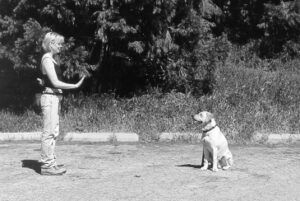
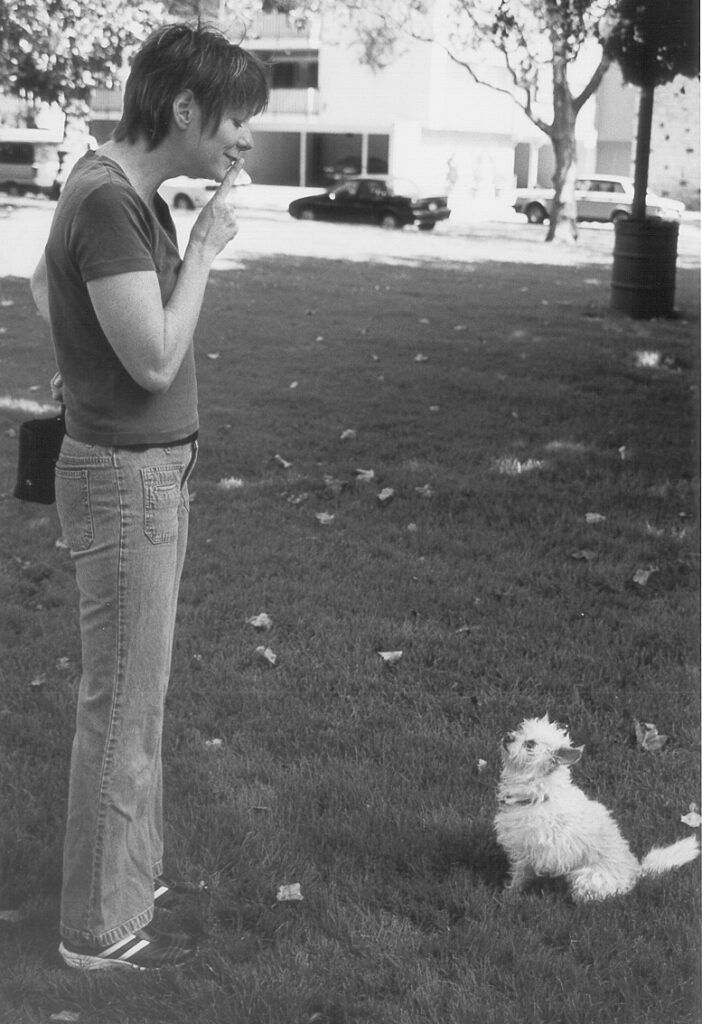
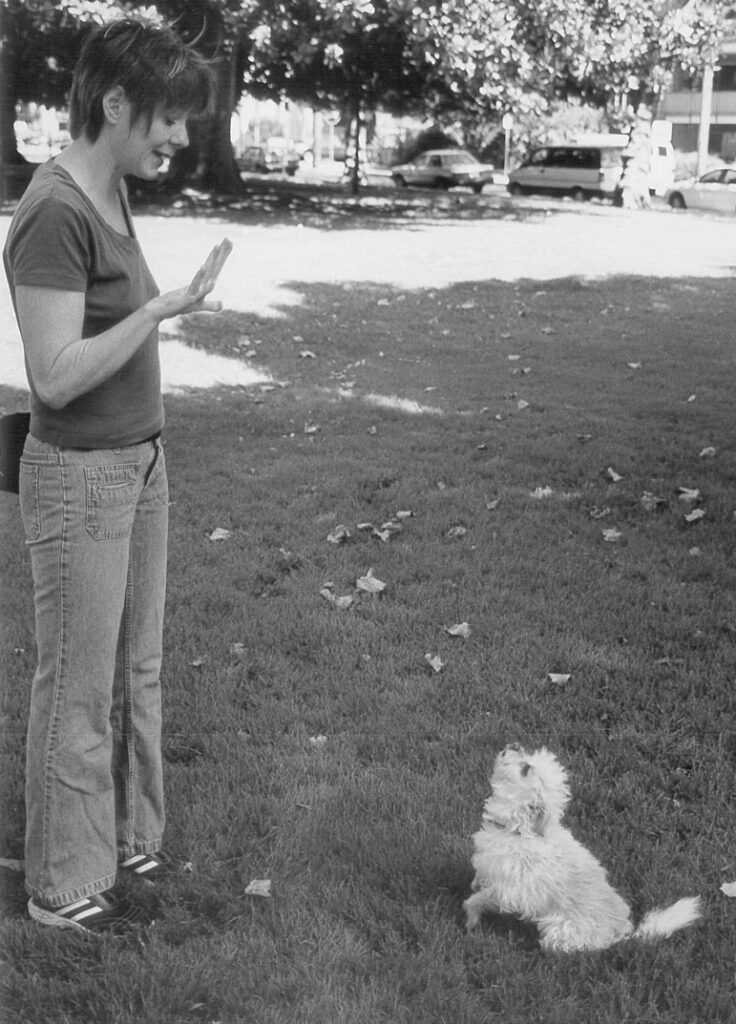


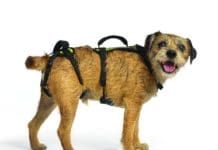

My service dog does all of the above but this is one of the best articles I have read for such training. The one thing I have not been able to find is how to train my dog to get me when the phone rings. I miss calls because of the hearing loss I have from service. Thanks again for a well written article.